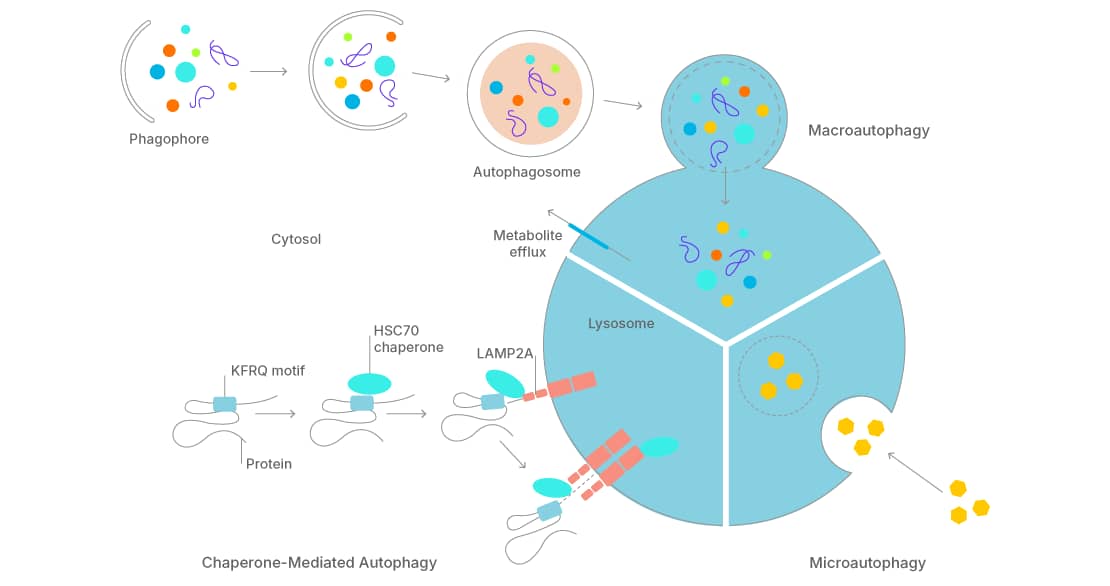Heat shock cognate 71 kDa protein (Hsc70), also known as HSPA8, is a member of the heat shock protein 70 family (Hsp70). Unlike Hsp70, it is a constitutively expressed chaperone protein and is involved in diverse cellular processes including protein folding and protein degradation. Hsc70 consists of two domains: the nucleotide binding domain (NBD) and the substrate binding domain (SBD). Hsc70, with the help of accessory proteins, exerts its chaperone activity by binding to short hydrophobic stretches of nascent or unfolded polypeptides through the SBD in an ATP-dependent manner. ATP hydrolysis then triggers a conformational change to induce protein folding and the release of the substrate. Nucleotide exchange factors then facilitate the exchange of ADP for ATP allowing Hsc70 to bind to a new substrate and repeat the cycle.
The ATPase activity of Hsc70 is also important for endocytosis during the uncoating of clathrin-coated vesicles. In conjunction with cochaperones, Hsc70 removes clathrin from vesicles after they pinch off the plasma membrane. Hsc70 also plays a role in nucleocytoplasmic transport by shuttling across the nuclear membrane in an ATP-dependent manner and helping to export and recycle the nuclear import receptor importin. Additionally, during chaperone mediated autophagy, Hsc70 recognizes misfolded or denatured substrates and along with a set of cochaperones targets them to the lysosome where the substrate is unfolded and translocated across the lysosomal membrane for degradation.

Chaperone-Mediated Autophagy: Chaperone proteins (e.g., heat shock cognate 70 protein; HSC-70) interact with cytosolic proteins destined for degradation. This complex is recognized by a lysosomal-associated membrane protein-2A (LAMP-2A), resulting in the translocation of the unfolded cytosolic protein into the lysosome.
The Kasamatsu group at UCLA sought to identify cytoplasmic chaperones that mediate the proper folding of new viral proteins (1). They used the Hsc70 antibody during immunoprecipitation experiments to identify chaperones that interact with and help fold SV40 viral proteins.
Many neurodegenerative disorders are often associated with protein misfolding. Dr. Brown from the University of Toronto examined the localization of constitutively expressed chaperone proteins in different regions of the brain (2). Through immunofluorescence performed with the Hsc70 antibody they identified a correlation between the levels of Hsc70 protein in different classes of neurons and the frequency at which those classes of neurons were affected by Parkinson's disease and Alzheimer's disease.
In the Journal of Biological Chemistry, the Brown group from Harvard investigated the role of heat shock family proteins in aquaporin-2 trafficking (3). The Hsc70 antibody allowed them to identify a direct interaction with aquaporin-2 through immunoprecipitation that was important for protein trafficking. In a recent article from the Semenza group at Johns Hopkins, Hsc70 and the chaperone mediated autophagy pathway were identified as important regulators of HIF-1 alpha levels through lysosomal degradation (4). A direct interaction of HIF-1 alpha and Hsc70 was identified through immunoprecipitation with the Hsc70 antibody and immunofluorescence experiments showed this interaction takes place at the lysosome. Finally, Welsch et al. sought to identify the role of Eps8 protein in cancer cells (5). They demonstrated Eps8 specifically localizes to lysosomes in cancer cells. They also used the Hsc70 antibody to show Eps8 interacts with the chaperone mediated autophagy proteins. Their research identified potential regulatory roles for Eps8 in autophagy in cancer cells that could promote cell survival and proliferation.
PMIDs
- 18945763
- 17441507
- 17636261
- 23457305
- 20184880